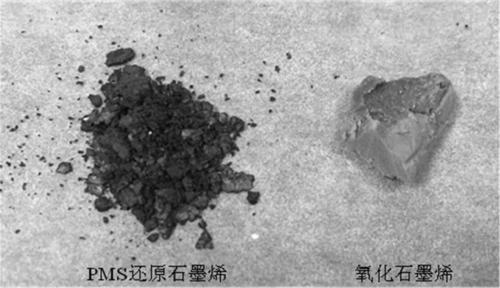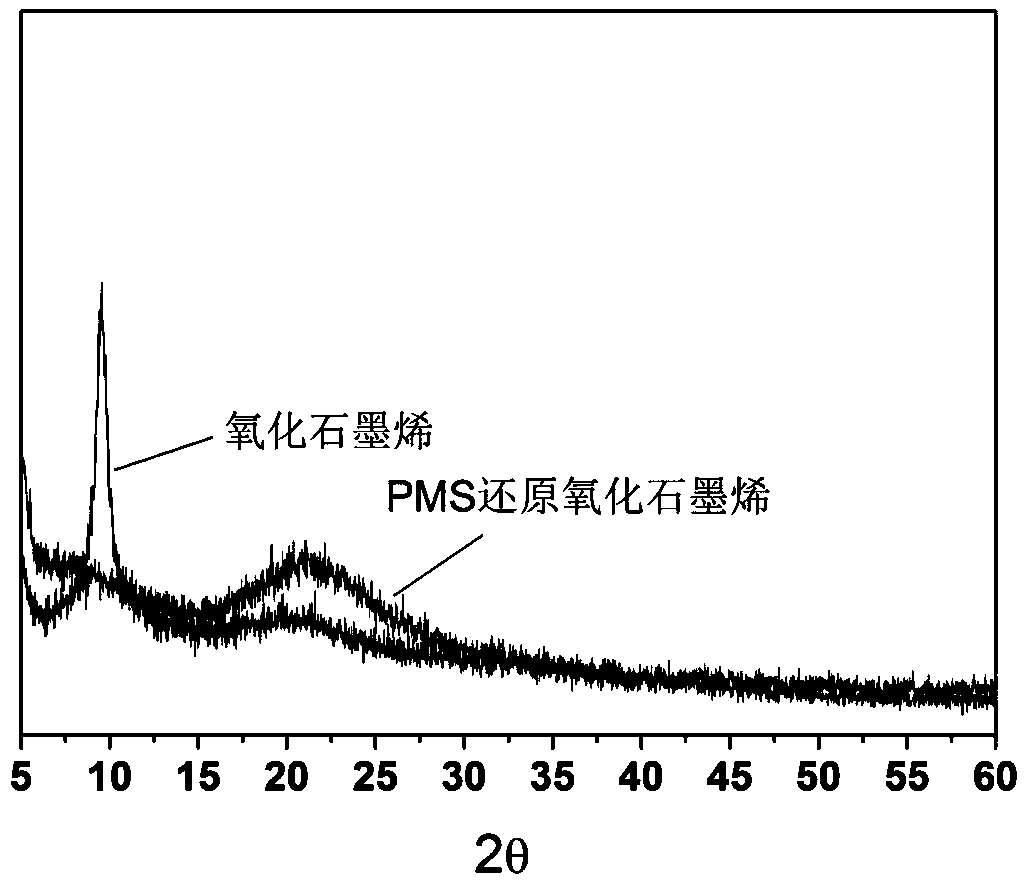Preparation method of graphene and graphene
A graphene, graphene solution technology, applied in the direction of graphene, nano-carbon, etc., can solve the problems of high toxicity of reducing agent, easy agglomeration of products, etc., and achieve the effects of improving preparation efficiency and performance, not easy to agglomerate, and mild conditions
- Summary
- Abstract
- Description
- Claims
- Application Information
AI Technical Summary
Problems solved by technology
Method used
Image
Examples
Embodiment 1
[0032] A method for preparing graphene of the present invention mainly uses polymethylhydrosilane (PMS) as a reducing agent to reduce graphene oxide to obtain graphene.
[0033] Specific steps are as follows:
[0034] (1) Ultrasonic disperse 10 mg of graphene oxide in 100 mL of dichloromethane at 20°C to obtain a 0.1 g / L graphene oxide suspension. Dissolve 100 mg of polymethylhydrogensilane in 100 mL of dichloromethane at room temperature to obtain a 1 g / L polymethylhydrogensilane solution.
[0035] (2) Mix the graphene oxide suspension obtained in step (1) with a polymethylhydrosilane (PMS) solution, and the mass ratio of graphene oxide in the mixed solution to polymethylhydrosilane (PMS) is 1: 10. Add 1 mg of chloroplatinic acid to the mixture, and stir at room temperature for 12 hours to obtain a graphene solution.
[0036] (3) After centrifuging the above graphene solution, discard the supernatant, then wash the residual solvent on the precipitate with n-hexane, and then...
Embodiment 2
[0039] A method for preparing graphene of the present invention mainly uses polyphenylhydrosilane as a reducing agent to reduce graphene oxide to obtain graphene.
[0040] Specific steps are as follows:
[0041] (1) Ultrasonic disperse 100mg of graphene oxide in 100mL of dichloromethane at 20°C to obtain a 1g / L graphene oxide suspension. 100 mg of polyphenylhydrosilane was dissolved in 100 mL of dichloromethane at room temperature to obtain a 1 g / L polyphenylhydrosilane solution.
[0042] (2) Mix the graphene oxide suspension obtained in step (1) with the polyphenylhydrosilane solution, the mass ratio of graphene oxide and polyphenylhydrosilane in the mixed solution is 1:1, in the mixed solution Add 1mg of chloroplatinic acid and stir at room temperature for 72h to obtain a graphene solution.
[0043] (3) After centrifuging the above graphene solution, discard the supernatant, then wash the residual solvent on the precipitate with n-hexane, and then wash away the polyphenyle...
Embodiment 3
[0045] A method for preparing graphene of the present invention mainly uses polyphenylhydrosilane as a reducing agent to reduce graphene oxide to obtain graphene.
[0046] Specific steps are as follows:
[0047] (1) Ultrasonic disperse 100mg of graphene oxide in 100mL of dichloromethane at 20°C to obtain a 1g / L graphene oxide suspension. Dissolve 1 g of polymethylsilane in 100 mL of dichloromethane at room temperature to obtain a 10 g / L polymethylsilane solution.
[0048] (2) Mix the graphene oxide suspension obtained in step (1) with the polymethylsilane solution, the mass ratio of graphene oxide and polymethylsilane in the mixture is 1:10, add 1mg Chloroplatinic acid, stirred at room temperature for 24h to obtain a graphene solution.
[0049] (3) After centrifuging the above graphene solution, discard the supernatant, then wash the residual solvent on the precipitate with n-hexane, and then wash away the polyformaldehyde grafted on the graphene surface with 0.1mol / L hydrof...
PUM
 Login to View More
Login to View More Abstract
Description
Claims
Application Information
 Login to View More
Login to View More - R&D
- Intellectual Property
- Life Sciences
- Materials
- Tech Scout
- Unparalleled Data Quality
- Higher Quality Content
- 60% Fewer Hallucinations
Browse by: Latest US Patents, China's latest patents, Technical Efficacy Thesaurus, Application Domain, Technology Topic, Popular Technical Reports.
© 2025 PatSnap. All rights reserved.Legal|Privacy policy|Modern Slavery Act Transparency Statement|Sitemap|About US| Contact US: help@patsnap.com


